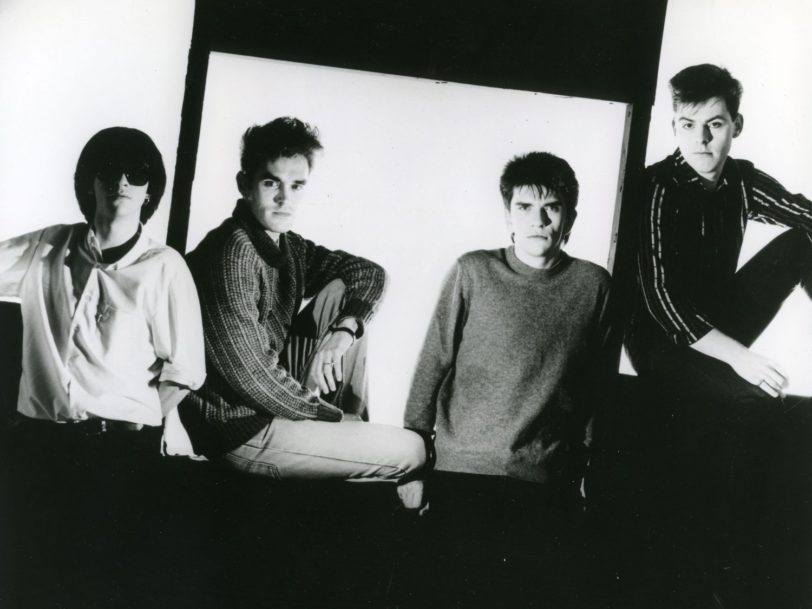Such is the strength of The Smiths singles catalogue that any serious attempt to isolate their ultimate signature song is probably doomed from the start. However, if push comes to shove and fans are forced to nominate their heroes’ definitive hit, then many are liable to lean towards This Charming Man.
Indeed, while you can argue that How Soon Is Now? remains the band’s most sonically groundbreaking track, you can make an equally credible case for This Charming Man as the most important song in their canon. Driven by Johnny Marr’s instantly recognisable jangly guitar riffs and one of Andy Rourke’s best basslines, the song represents the sound of indie-pop at the very top of its game, and its success significantly furthered The Smiths’ cause, providing them with their Top 30 breakthrough during the late autumn of 1983.
“I just leapt out of bed and wrote it”
Bearing in mind what it achieved for Morrissey and co, it’s ironic that This Charming Man wasn’t initially chosen as the follow-up to the band’s critically-hailed debut single, Hand In Glove. Reel Around The Fountain had been earmarked for this role until Johnny Marr heard a freshly-minted song by The Smiths’ Rough Trade labelmates Aztec Camera. Penned by that band’s precocious young singer-songwriter Roddy Frame, the sophisticated Walk Out To Winter spurred Marr into raising his game creatively.
“I wrote This Charming Man for a John Peel session,” Marr recalled in The Guardian in 2011. “I just leapt out of bed and wrote it. It was the culmination of trying to find a way of playing that was non-rock but still expressed my personality. I felt we needed something more upbeat in a different key and was miffed that Aztec Camera’s Roddy Frame was getting on the radio and we weren’t. That’s why it’s got that sunny disposition; my usual default setting was Manchester in the rain. When we were recording it, Rough Trade’s Geoff Travis came in and said: ‘That’s got to be the single.’”
With Morrissey’s erudite lyric (“Why pamper life’s complexity/When the leather runs smooth on the passenger seat?”) further adding to the song’s allure, The Smiths were sure they were onto something special. However, capturing This Charming Man’s full potential proved elusive. Neither the group nor producer John Porter were happy with the results of an initial session at London’s Matrix Studios, and it was only when the team decamped to Stockport’s Strawberry Studio for a second attempt that they nailed the song’s definitive take.
“That song was just life-changing”
Their perseverance paid dividends, for all concerned brought their A-game along to the Strawberry session. Andy Rourke and Mike Joyce performed the song’s Motown-esque rhythm track with flair and efficiency, providing the ideal bedrock for Marr’s effervescent guitars and Morrissey’s mournful, yet charismatic vocal delivery. Between the two sessions, Marr and Porter also devised the missing piece of the puzzle – a blissful introductory guitar riff which Smiths biographer Tony Fletcher later noted “demonstrated how a good guitar intro could sell a whole song”.
Certainly, The Smiths patented something truly special with This Charming Man. The confidence of the band’s performance and Morrissey’s sexually ambiguous wordplay (“This man said it’s gruesome/That someone so handsome should care”) both drew widespread acclaim, with the NME’s Paul Morley praising the song’s “accessible bliss” and declaring it to be “one of the singles of the year”.
The advance notices soon translated into sales, as This Charming Man swept into the charts after its official release on 31 October 1983. Coupled with a brace of killer B-sides, including Jeane and the unsung Wonderful Woman, it proved an essential purchase for the band’s nascent fanbase, and its chart peak of No.25 earned The Smiths their legendary Top Of The Pops debut.
“Nothing had been handed to us on a plate, and we were ready”
“Everyone remembers the flowers Morrissey took on to the show,” Johnny Marr recalled in 2011. “I’d been very aware of how powerful Top Of The Pops could be visually, from my childhood watching T. Rex. We’d first used gladioli onstage at the Haçienda about a year before, to counteract the all-encompassing austere aesthetic of Factory Records…
“Morrissey was using those gladioli in a way that was far from fey, almost brandishing them,” Marr added. “Morrissey provided flamboyance, while the rest of us wore sweaters and provided a streetwise, gang aspect. We’d had a year of rejections, getting in the trenches; nothing had been handed to us on a plate, and we were ready.”
Now hailed as one of the best Smiths songs of all time, This Charming Man’s success proved categorically that the group were, indeed, primed to take on the mainstream. In fact, it became the first of 15 UK Top 30 hits the band chalked up during their active lifetime, and its unique sound has gone on to influence much of Manchester’s best music in subsequent decades.
“The second I heard This Charming Man everything made sense,” Noel Gallagher told Uncut in 2007. “The sound of that guitar intro was incredible, and those lyrics are fuckin’ amazing, too. People say Morrissey’s miserable, but I knew straight away what he was on about. That song was just life-changing for me.”
Buy Smiths vinyl at the Dig! store.
More Like This
Vogue: The Story Behind Madonna’s Most Celebrated Video
As iconic as it gets, the promo video for Madonna’s Vogue single proved that the “Queen Of Pop” was all about making high art.
What’s Love Got To Do With It: Behind Tina Turner’s Universally Adored Anthem
A true 80s mega-hit, What’s Love Got To Do With It defined Tina Turner’s career, if not her outlook on life…
Be the first to know
Stay up-to-date with the latest music news, new releases, special offers and other discounts!




